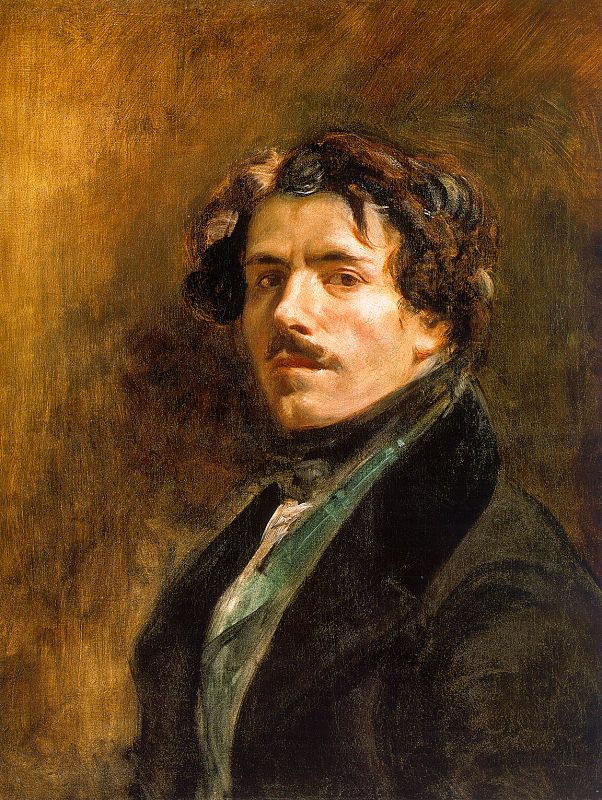
Self Portrait (1837)
Delacroix’s distinctiveness was in part due to the circumstances of the time. He was born in 1798 at the end of the French Revolution, the son of Charles-François Delacroix, ambassador to the Netherlands, and Victoire Oeben, the daughter of a celebrated cabinet maker. Since Eugène arrived seven months after Charles had undergone a major testicular operation, his natural father was widely thought to be the éminence grise statesman Charles-Maurice de Talleyrand, a friend of the family and a minister under five successive regimes. Such parentage would perhaps help explain where Delacroix got his patrician airs.
Delacroix entered the studio of the neoclassical painter Pierre-Narcisse Guérin, but the greatest impact on his style came from studying the old masters in the Louvre, in particular Rubens and the Venetians, and from more senior contemporaries such as Antoine-Jean Gros and Théodore Géricault. Taken together these influences gave him an interest in colour, movement, imagination and grand historical and literary topics. This heady hotchpotch was intensified by his adulation for the work of Shakespeare, Walter Scott and Byron – indeed, as an adolescent, Delacroix wrote two historical novellas and a play.
Delacroix’s early manhood coincided with the end of the Napoleonic adventure and the return of the Bourbon monarchy, the unloved dynasty that famously “forgot nothing but learned nothing”. The young painter was faced with the dilemma that so many of his generation had to contend with: how to live a heroic life in an unheroic age. It was the problem that obsessed both Géricault and Stendhal. Delacroix’s response was to turn backwards for his themes but to paint them in a forwards-looking way.
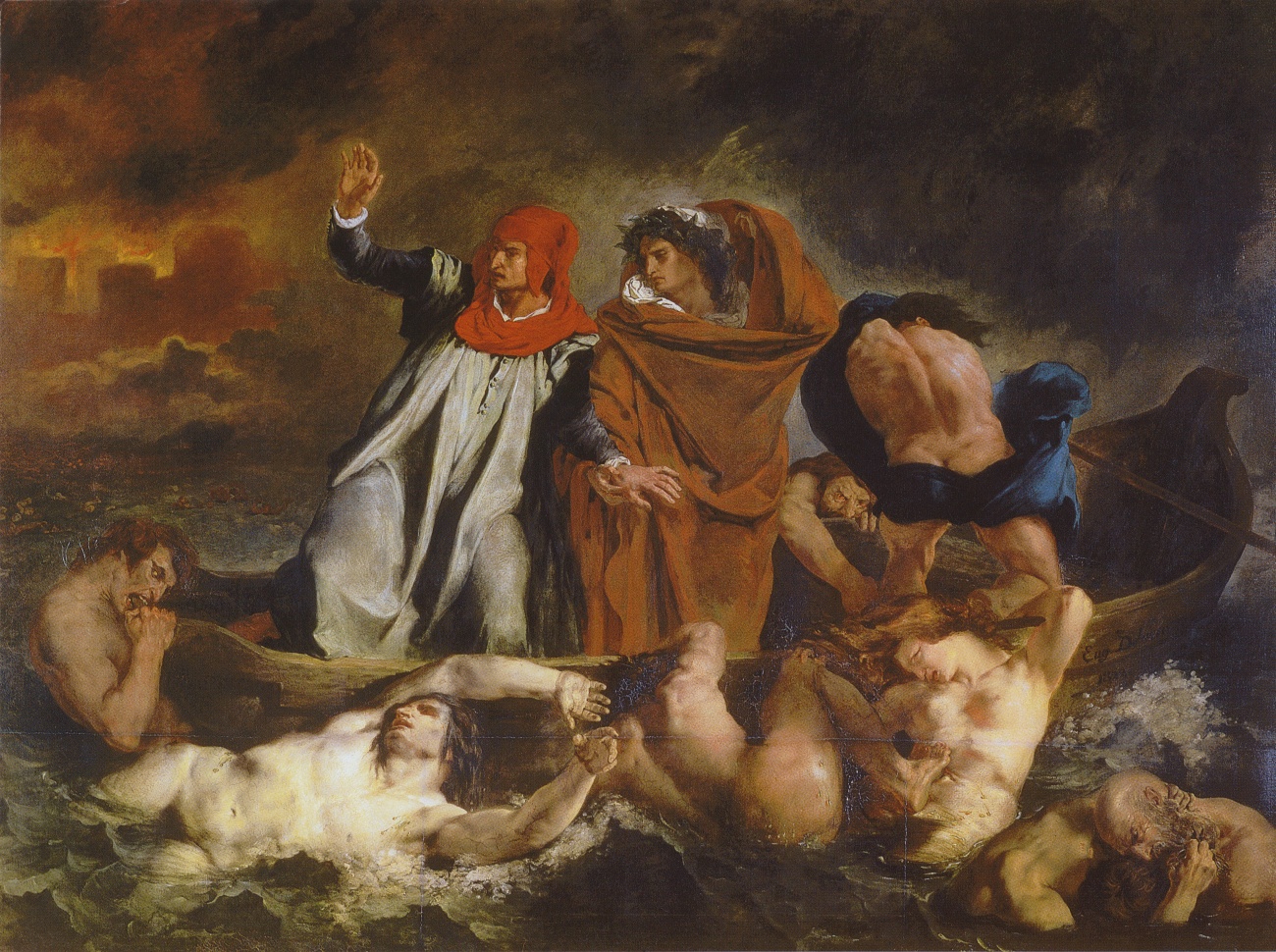
In his first Salon submission, The Barque of Dante (1822), he already showed the characteristics that Baudelaire isolated as defining his art: “the atmosphere of the human drama and the state of the creator’s soul”. It also showed him to be a formidable colourist and theoretician of colour – the water drops on the bodies of the damned souls who menace Dante and Virgil as they cross the Styx are formed of separate touches of green, yellow and red that blend not on the canvas but in the viewer’s eye.
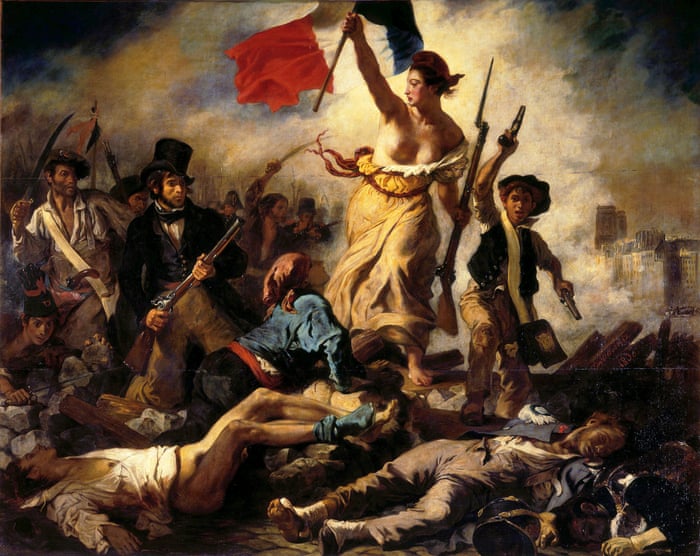
http://www.theguardian.com/artanddesign/2016/feb/05/damned-souls-decadence-eugene-delacroix-hero
http://www.nationalgallery.org.uk/delacroix
Damnation, Dante and decadence: why Eugène Delacroix is making a hero’s return
From Van Gogh to Cézanne to Picasso, Delacroix was revered by the very artists who would come to overshadow him. Now his pessimistic vision looks set for critical acclaim once again
Michael Prodger
Friday 5 February 2016
Eugène Delacroix today holds, for many people, a somewhat peripheral place in the pantheon of 19th-century artists. That he was a powerful influence on the likes of Manet, the impressionists and Seurat is taken for granted, but so too is the idea that they went on to outstrip him. For the poet and art critic Charles Baudelaire, however, such a reversal of reputation was inconceivable. Delacroix, in his eyes, was peerless. In his review of the Salon exhibition of 1845 he stated startlingly and unequivocally: “M Delacroix is decidedly the most original painter of ancient or modern times. That is how things are, and what is the good of protesting?”
What made him such an original was not just his artistic range – from crucifixions to portraits to tigers to vast mythological ceiling paintings – and the fluidity of his colour and drawing, but his personality. Delacroix, said Baudelaire, was “a volcanic crater artfully concealed behind bouquets of flowers” and as fascinating for his enigmatic aloofness as for his art. His contemporaries also saw in this Anglophile dandy someone who remained stubbornly and defiantly true to himself despite the disdain of officialdom and the brickbats that were frequently directed at his work from the academy. His indifference and determination to survive outside critical and state support were, for younger painters, inspirational.
This admiration for the person as much as the painter was tangible. Odilon Redon recalled stalking Delacroix at a ball in 1859 and overhearing him being introduced to a Bonaparte princess who wanted “to see a great artist”: “You see,” countered Delacroix, “he’s not very big.” In physical stature perhaps not – he had life-long ill health and a bit of a stoop – in every other way though successors viewed him as a giant. “We all paint in Delacroix’s language,” said Cézanne. “That bastard. He’s really good,” grudgingly admitted Picasso – not a man who willing acknowledged having equals.
Delacroix and the Rise of Modern Art, the National Gallery’s new exhibition, sets out to restore the painter to his 19th-century eminence by presenting him as the missing link of modernism. The starting point of modern art is often too tidily dated to 1863 and the Salon des Refusés when France’s avant-garde painters, spurned by the art establishment, held an exhibition of their own. The National’s show will have none of that: Delacroix, who died, aged 65, the year of the Refusés, is the key figure and the exhibition traces the course of his influence through to 50 years after his death.
The case is hard to argue against. The impressionists, post-impressionists, pointillists, symbolists, expressionists and modernists all drew on Delacroix. The individual artists that owe him a debt form an impressive roster: Van Gogh,Gauguin, Seurat, Signac, Fantin-Latour, Redon, Monet, Cézanne, Whistler, Manet, Gustave Moreau, Matisse, Picasso and more. As do the writers, among them Stendhal, Gautier, Proust and Henry James. There could nevertheless be a matching exhibition of equal validity, Delacroix and the End the Grand Tradition, since he was the heir to a type of grand, public art that had been prevalent since the Renaissance. The critic Lorenz Eitner called Delacroix “the last great European painter to use the repertory of humanistic art with conviction and originality”. He was the preeminent religious and mythological painter of the 19th century and he almost never depicted the modern world – and when he did, he painted it as allegory. When once praised enthusiastically as the quintessential Romantic artist, he responded: “You are mistaken sir, I am a pure classicist.”
From Van Gogh to Cézanne to Picasso, Delacroix was revered by the very artists who would come to overshadow him. Now his pessimistic vision looks set for critical acclaim once again
Michael Prodger
Friday 5 February 2016
Eugène Delacroix today holds, for many people, a somewhat peripheral place in the pantheon of 19th-century artists. That he was a powerful influence on the likes of Manet, the impressionists and Seurat is taken for granted, but so too is the idea that they went on to outstrip him. For the poet and art critic Charles Baudelaire, however, such a reversal of reputation was inconceivable. Delacroix, in his eyes, was peerless. In his review of the Salon exhibition of 1845 he stated startlingly and unequivocally: “M Delacroix is decidedly the most original painter of ancient or modern times. That is how things are, and what is the good of protesting?”
What made him such an original was not just his artistic range – from crucifixions to portraits to tigers to vast mythological ceiling paintings – and the fluidity of his colour and drawing, but his personality. Delacroix, said Baudelaire, was “a volcanic crater artfully concealed behind bouquets of flowers” and as fascinating for his enigmatic aloofness as for his art. His contemporaries also saw in this Anglophile dandy someone who remained stubbornly and defiantly true to himself despite the disdain of officialdom and the brickbats that were frequently directed at his work from the academy. His indifference and determination to survive outside critical and state support were, for younger painters, inspirational.
This admiration for the person as much as the painter was tangible. Odilon Redon recalled stalking Delacroix at a ball in 1859 and overhearing him being introduced to a Bonaparte princess who wanted “to see a great artist”: “You see,” countered Delacroix, “he’s not very big.” In physical stature perhaps not – he had life-long ill health and a bit of a stoop – in every other way though successors viewed him as a giant. “We all paint in Delacroix’s language,” said Cézanne. “That bastard. He’s really good,” grudgingly admitted Picasso – not a man who willing acknowledged having equals.
Delacroix and the Rise of Modern Art, the National Gallery’s new exhibition, sets out to restore the painter to his 19th-century eminence by presenting him as the missing link of modernism. The starting point of modern art is often too tidily dated to 1863 and the Salon des Refusés when France’s avant-garde painters, spurned by the art establishment, held an exhibition of their own. The National’s show will have none of that: Delacroix, who died, aged 65, the year of the Refusés, is the key figure and the exhibition traces the course of his influence through to 50 years after his death.
The case is hard to argue against. The impressionists, post-impressionists, pointillists, symbolists, expressionists and modernists all drew on Delacroix. The individual artists that owe him a debt form an impressive roster: Van Gogh,Gauguin, Seurat, Signac, Fantin-Latour, Redon, Monet, Cézanne, Whistler, Manet, Gustave Moreau, Matisse, Picasso and more. As do the writers, among them Stendhal, Gautier, Proust and Henry James. There could nevertheless be a matching exhibition of equal validity, Delacroix and the End the Grand Tradition, since he was the heir to a type of grand, public art that had been prevalent since the Renaissance. The critic Lorenz Eitner called Delacroix “the last great European painter to use the repertory of humanistic art with conviction and originality”. He was the preeminent religious and mythological painter of the 19th century and he almost never depicted the modern world – and when he did, he painted it as allegory. When once praised enthusiastically as the quintessential Romantic artist, he responded: “You are mistaken sir, I am a pure classicist.”
Delacroix’s distinctiveness was in part due to the circumstances of the time. He was born in 1798 at the end of the French Revolution, the son of Charles-François Delacroix, ambassador to the Netherlands, and Victoire Oeben, the daughter of a celebrated cabinet maker. Since Eugène arrived seven months after Charles had undergone a major testicular operation, his natural father was widely thought to be the éminence grise statesman Charles-Maurice de Talleyrand, a friend of the family and a minister under five successive regimes. Such parentage would perhaps help explain where Delacroix got his patrician airs.
Delacroix entered the studio of the neoclassical painter Pierre-Narcisse Guérin, but the greatest impact on his style came from studying the old masters in the Louvre, in particular Rubens and the Venetians, and from more senior contemporaries such as Antoine-Jean Gros and Théodore Géricault. Taken together these influences gave him an interest in colour, movement, imagination and grand historical and literary topics. This heady hotchpotch was intensified by his adulation for the work of Shakespeare, Walter Scott and Byron – indeed, as an adolescent, Delacroix wrote two historical novellas and a play.
Delacroix’s early manhood coincided with the end of the Napoleonic adventure and the return of the Bourbon monarchy, the unloved dynasty that famously “forgot nothing but learned nothing”. The young painter was faced with the dilemma that so many of his generation had to contend with: how to live a heroic life in an unheroic age. It was the problem that obsessed both Géricault and Stendhal. Delacroix’s response was to turn backwards for his themes but to paint them in a forwards-looking way.

The Barque of Dante (1822)
In his first Salon submission, The Barque of Dante (1822), he already showed the characteristics that Baudelaire isolated as defining his art: “the atmosphere of the human drama and the state of the creator’s soul”. It also showed him to be a formidable colourist and theoretician of colour – the water drops on the bodies of the damned souls who menace Dante and Virgil as they cross the Styx are formed of separate touches of green, yellow and red that blend not on the canvas but in the viewer’s eye.

Liberty Leading the People (1831)
Unlike many of the Romantics, Delacroix actively sought state patronage and acceptance, although the latter was late in coming – he had to apply seven times to join the Académie des Beaux Arts before he was finally accepted. The Barque of Dante was bought by the state, as was Liberty Leading the People (1831). This painting, depicting the July Revolution of 1830 which toppled Charles X and brought the “Bourgeois King” Louis-Philippe to the throne, was the closest Delacroix came to being a painter of modern life. Even here, though, his particular take on the heroic tradition is obvious and it has no room for the ideal. The popular uprising may be a noble moment in history, but the insurgents that follow the lead of Marianne, the French Revolutionary goddess of liberty, are a coarse and ramshackle group. Delacroix felt little sympathy for his fellow citizens (the mob was not his thing and nor were the middle classes with their “wholly new barbarism”). He wrote to his brother, a general, that, while he had not “conquered for the fatherland, he would at least paint for it”.
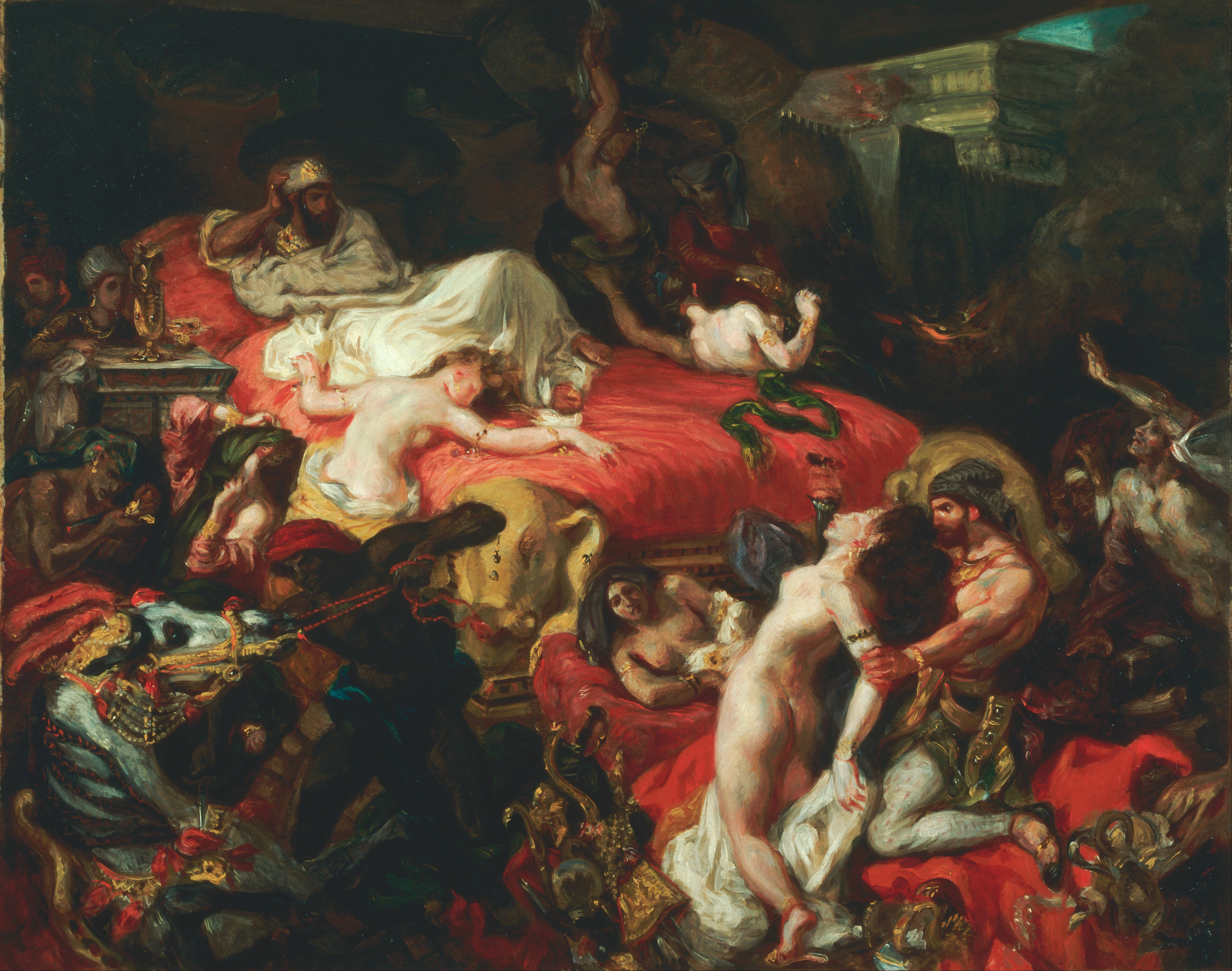
The picture, which was later returned to him for being “too revolutionary”, was in part an attempt by Delacroix to overcome his true instincts. These had been paraded in 1827 in the huge and provocative The Death of Sardanapalus, a painting that was widely vilified. The subject, taken from a play by Byron (the man who inspired in him “that insatiable longing to create”), shows the cruel and jaded Assyrian potentate sitting on a bed atop his funeral pyre as his enemies storm Nineveh and close in on him. He will not go up in flames alone, however, and orders all his royal chattels – concubines, horses, jewels, slaves – to join him in immolation. Quite what Delacroix thought he was up to in painting this vortex of luxury and death is unclear. Brilliantly and rapidly assembled, the picture was nevertheless castigated as aberrant in both technique (“a potboiler with neither top nor bottom”) and in taste, and the painter received an official warning. Sardanapalus, a voyeur at the heart of this maelstrom of slaughter, also has uncomfortable overtones of self-portraiture.
Joris-Karl Huysmans, the “decadent” author of Against Nature, never met Delacroix but he had Sardanapalus in mind when he summed up the painter: “Strange man, almost always imperfect, ill-tempered and languid, superb when his fever burns, theatrical and melodramatic when it smoulders, he has been a titanic force against the comatose in art, strychnine electrifying the old julep prescribed by the recipes of the dyers of grand art.”
If Sardanapalus was an essay in literary Orientalism, Delacroix came face to face with the real thing when he visited north Africa in 1832 as part of a diplomatic mission led by the Comte de Mornay. In Morocco and Algeria Delacroix encountered a world “As beautiful as antiquity … The heroes of [Jacques-Louis] David and Co, with their rose pink limbs, would cut a sorry figure beside these children of the sun, who wear the dress of classical antiquity with a nobler air.” He sketched and painted watercolours obsessively, his subjects ranging from parading Arab horsemen and ecstatic religious processions to a Jewish wedding and the harem: “I am like a man in a dream,” he wrote, “seeing things he fears will vanish from him.”
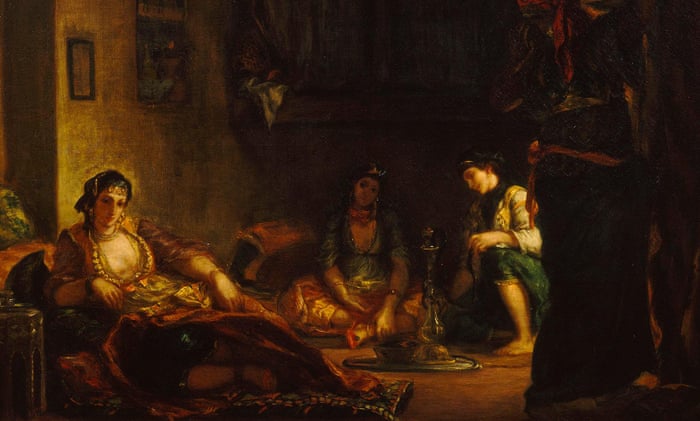 A detail from Women of Algiers (1847-9)
A detail from Women of Algiers (1847-9)
On his return to France, these sketches and visual memories formed a rich repertoire: nearly 80 oil paintings and innumerable drawings, lithographs and etchings grew out of them. The most potent subject, perhaps, was the women’s apartments he had managed to see in a Muslim house in Algeria. He glimpsed this forbidden world through the indulgence of a Christian turned Muslim convert who was working for the French and who allowed the artist into his own home: “It is beautiful! Like the age of Homer,” said the wonderstruck painter. Women of Algiers in Their Apartment of 1834, of which he painted two versions, is an exercise in subdued eroticism. Exotic, otherworldly, sensual, richly patterned with colour and light, the picture is a subtle and personal melding of external reality and internal feeling.
Women of Algiers was a sensation at the Salon and harbinger of a slew of “harem” pictures by lesser artists which coarsened Delacroix’s vision of art for art’s sake. Here, mood and beauty of form, rather than narrative, are paramount, producing what he called “the music of painting”. Cézanne was among the younger artists for whom the picture was a revelation: “All this luminous colour – it seems to me that it enters the eye like a glass of wine running into your gullet and it makes you drunk straight away.” The picture later obsessed Picasso who painted 15 variants – one of which last year became the most expensive work of art ever sold at auction when it fetched $179.4m (£125m) – and drew and etched almost 60 more. Curiously, Picasso, Delacroix’s most obsessive “modern” adherent, falls outside the scope of the National Gallery’s exhibition.
What Delacroix found in north Africa was confirmation of his painterly principles. The last entry in the Journal that he kept properly from 1847 reads: “The first merit of a painting is to be a feast for the eye … it’s like beautiful verses; nothing in the world will prevent them from being bad if they shock the ear.” Literalism was his bugbear: “The forms of the model, whether it is a tree or a man, are only the dictionary where the artist goes to give renewed force to his fugitive impressions.” For Delacroix, a painting should bring forth the viewer’s own memories of nature. He was implacably opposed to the “petty details” and “the love of exactitude, which most people take for truth” and the “pernicious archaism” of his artistic opposite Ingres. “Cold exactitude is not art,” he said, “The feigned conscientiousness of our majority of painters is only perfection applied to the art of being boring.” For all his icy self-control, Delacroix was never boring.
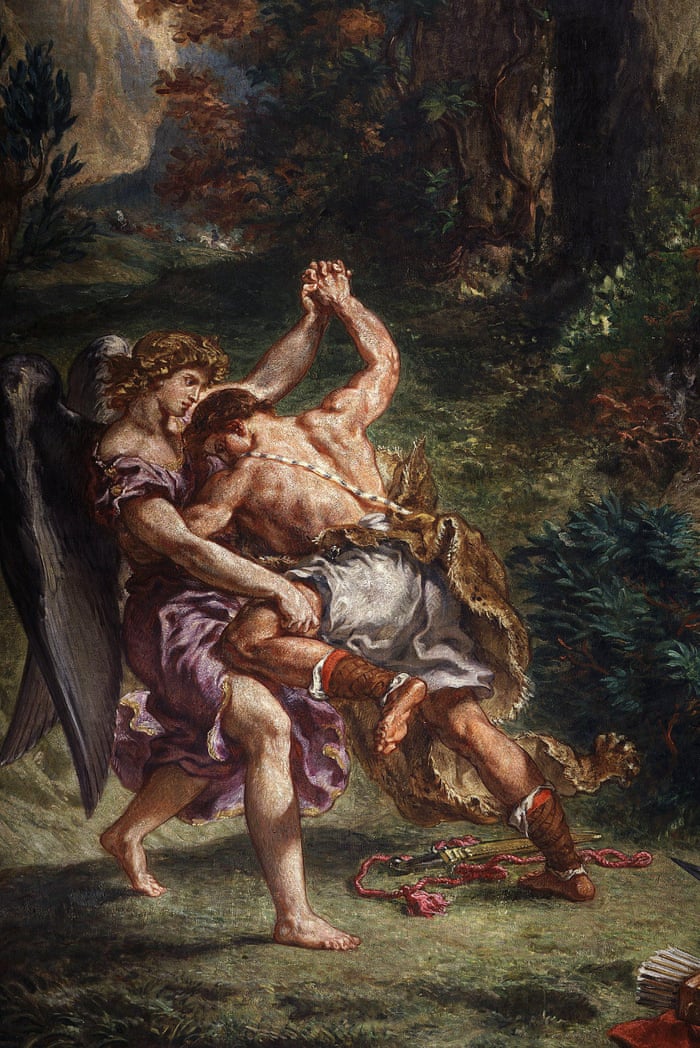
The artist did eventually find establishment acceptance. In 1855 he was given a pavilion at the Exposition Universelle and, with the help of his friend the prime minister, Adolphe Thiers, was awarded mythological commissions for various government buildings around Paris. And in the Chapelle des Saints-Anges in Saint Sulpice he painted the last great religious mural cycle in western art, with its key image of Jacob Wrestling the Angel a metaphor for his own artistic struggles. Nevertheless, just as he was not a believer in the modern world, so he was a religious agnostic: what followed life, he believed, was “Night, dreadful night.”
If fellow painters emulated his doubt, his pessimism and his style, where they couldn’t follow him was in his emotional life. Delacroix, said Baudelaire, “was passionately in love with passion” – but not, it seems, in affairs of the heart. He never married, there is no record of love affairs and his closest female companion was his housekeeper. His emotional life, the natural realm for a man of his sensibilities, was a void. It was perhaps in this, the acceptance of his own contradictions, that he was at his most modern.
•Delacroix and the Rise of Modern Art is at the National Gallery, London WC2N, from 17 February.
Unlike many of the Romantics, Delacroix actively sought state patronage and acceptance, although the latter was late in coming – he had to apply seven times to join the Académie des Beaux Arts before he was finally accepted. The Barque of Dante was bought by the state, as was Liberty Leading the People (1831). This painting, depicting the July Revolution of 1830 which toppled Charles X and brought the “Bourgeois King” Louis-Philippe to the throne, was the closest Delacroix came to being a painter of modern life. Even here, though, his particular take on the heroic tradition is obvious and it has no room for the ideal. The popular uprising may be a noble moment in history, but the insurgents that follow the lead of Marianne, the French Revolutionary goddess of liberty, are a coarse and ramshackle group. Delacroix felt little sympathy for his fellow citizens (the mob was not his thing and nor were the middle classes with their “wholly new barbarism”). He wrote to his brother, a general, that, while he had not “conquered for the fatherland, he would at least paint for it”.

The Death of Sardanapalus (1846)
The picture, which was later returned to him for being “too revolutionary”, was in part an attempt by Delacroix to overcome his true instincts. These had been paraded in 1827 in the huge and provocative The Death of Sardanapalus, a painting that was widely vilified. The subject, taken from a play by Byron (the man who inspired in him “that insatiable longing to create”), shows the cruel and jaded Assyrian potentate sitting on a bed atop his funeral pyre as his enemies storm Nineveh and close in on him. He will not go up in flames alone, however, and orders all his royal chattels – concubines, horses, jewels, slaves – to join him in immolation. Quite what Delacroix thought he was up to in painting this vortex of luxury and death is unclear. Brilliantly and rapidly assembled, the picture was nevertheless castigated as aberrant in both technique (“a potboiler with neither top nor bottom”) and in taste, and the painter received an official warning. Sardanapalus, a voyeur at the heart of this maelstrom of slaughter, also has uncomfortable overtones of self-portraiture.
Joris-Karl Huysmans, the “decadent” author of Against Nature, never met Delacroix but he had Sardanapalus in mind when he summed up the painter: “Strange man, almost always imperfect, ill-tempered and languid, superb when his fever burns, theatrical and melodramatic when it smoulders, he has been a titanic force against the comatose in art, strychnine electrifying the old julep prescribed by the recipes of the dyers of grand art.”
If Sardanapalus was an essay in literary Orientalism, Delacroix came face to face with the real thing when he visited north Africa in 1832 as part of a diplomatic mission led by the Comte de Mornay. In Morocco and Algeria Delacroix encountered a world “As beautiful as antiquity … The heroes of [Jacques-Louis] David and Co, with their rose pink limbs, would cut a sorry figure beside these children of the sun, who wear the dress of classical antiquity with a nobler air.” He sketched and painted watercolours obsessively, his subjects ranging from parading Arab horsemen and ecstatic religious processions to a Jewish wedding and the harem: “I am like a man in a dream,” he wrote, “seeing things he fears will vanish from him.”

On his return to France, these sketches and visual memories formed a rich repertoire: nearly 80 oil paintings and innumerable drawings, lithographs and etchings grew out of them. The most potent subject, perhaps, was the women’s apartments he had managed to see in a Muslim house in Algeria. He glimpsed this forbidden world through the indulgence of a Christian turned Muslim convert who was working for the French and who allowed the artist into his own home: “It is beautiful! Like the age of Homer,” said the wonderstruck painter. Women of Algiers in Their Apartment of 1834, of which he painted two versions, is an exercise in subdued eroticism. Exotic, otherworldly, sensual, richly patterned with colour and light, the picture is a subtle and personal melding of external reality and internal feeling.
Women of Algiers was a sensation at the Salon and harbinger of a slew of “harem” pictures by lesser artists which coarsened Delacroix’s vision of art for art’s sake. Here, mood and beauty of form, rather than narrative, are paramount, producing what he called “the music of painting”. Cézanne was among the younger artists for whom the picture was a revelation: “All this luminous colour – it seems to me that it enters the eye like a glass of wine running into your gullet and it makes you drunk straight away.” The picture later obsessed Picasso who painted 15 variants – one of which last year became the most expensive work of art ever sold at auction when it fetched $179.4m (£125m) – and drew and etched almost 60 more. Curiously, Picasso, Delacroix’s most obsessive “modern” adherent, falls outside the scope of the National Gallery’s exhibition.
What Delacroix found in north Africa was confirmation of his painterly principles. The last entry in the Journal that he kept properly from 1847 reads: “The first merit of a painting is to be a feast for the eye … it’s like beautiful verses; nothing in the world will prevent them from being bad if they shock the ear.” Literalism was his bugbear: “The forms of the model, whether it is a tree or a man, are only the dictionary where the artist goes to give renewed force to his fugitive impressions.” For Delacroix, a painting should bring forth the viewer’s own memories of nature. He was implacably opposed to the “petty details” and “the love of exactitude, which most people take for truth” and the “pernicious archaism” of his artistic opposite Ingres. “Cold exactitude is not art,” he said, “The feigned conscientiousness of our majority of painters is only perfection applied to the art of being boring.” For all his icy self-control, Delacroix was never boring.

A fresco detail from Jacob Wrestling the Angel (1855-61)
The artist did eventually find establishment acceptance. In 1855 he was given a pavilion at the Exposition Universelle and, with the help of his friend the prime minister, Adolphe Thiers, was awarded mythological commissions for various government buildings around Paris. And in the Chapelle des Saints-Anges in Saint Sulpice he painted the last great religious mural cycle in western art, with its key image of Jacob Wrestling the Angel a metaphor for his own artistic struggles. Nevertheless, just as he was not a believer in the modern world, so he was a religious agnostic: what followed life, he believed, was “Night, dreadful night.”
If fellow painters emulated his doubt, his pessimism and his style, where they couldn’t follow him was in his emotional life. Delacroix, said Baudelaire, “was passionately in love with passion” – but not, it seems, in affairs of the heart. He never married, there is no record of love affairs and his closest female companion was his housekeeper. His emotional life, the natural realm for a man of his sensibilities, was a void. It was perhaps in this, the acceptance of his own contradictions, that he was at his most modern.
•Delacroix and the Rise of Modern Art is at the National Gallery, London WC2N, from 17 February.









No comments:
Post a Comment